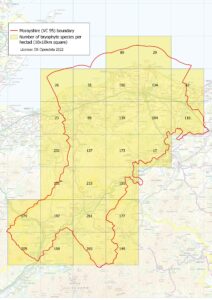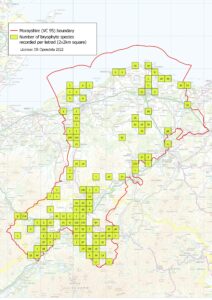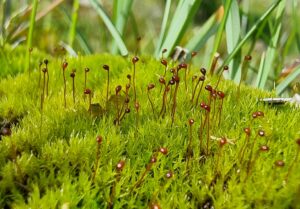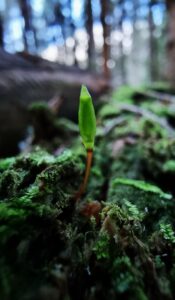Bryophytes in Morayshire
Rory Whitock - as published in 2022 Moray Field Club Bulletin
Introduction
A good starting point for this article would be to describe what a bryophyte is. It is a term used for a group of non-vascular plants that are largely unable to transport water and nutrients around the plant due to a lack of vascular tissue (though there are exceptions!). Bryophytes are composed of three main groups that include mosses, liverworts and hornworts. One of the wonderful things about bryophytes is that they are common throughout the British Isles and can be easily seen by most people by merely going into their gardens or out for a walk anywhere close to their home where they will find colonies bryophytes growing on garden walls, flower beds and even their own doorstep. In more natural settings they occupy most available niches from being pioneer colonists on bare or loose soil, festooning themselves on the branches of trees or growing on peatlands where they partially decompose to form the peat itself.
Scotland is particularly rich in bryophytes owing to our mild, wet conditions which persist throughout the year. As already mentioned, the lack of ability as a non-vascular plant to transport water and nutrients throughout the organism, mean that these constantly wet conditions are crucial to their survival and is the reason that they are so abundant in the country. Morayshire (Vice- County 95) has been somewhat neglected in terms of recent recording activities as most visiting bryologists are naturally drawn to the nearby Cairngorm mountains due to their specialist alpine bryophyte flora rather than largely lowland nature of Morayshire. Moray has however a very interesting and important bryophyte flora with many records of nationally rare and scarce species. There is also a range of habitats throughout the region which provide suitable niches for a wide diversity of species.
Habitats of particular importance include the sand dune sytems in the north such as those found at Culbin sands and Lossiemouth, the large, wooded sandstone gorges surrounding the river Findhorn, the extensive blanket bogs spanning across the Dava Moor, Caledonian pine forests such as Anagach woods in Grantown-on-Spey and the band of highly calcareous limestone that cuts through Glen Brown and Allt Iomadaidh in the far south-east of the county. All of which hold a specialist bryophyte assemblage in their own respect.
Bryophyte taxonomy is unfortunately in a state of flux with name changes happening faster than most bryologists can keep up with. For the purpose of this article, nomenclature follows that of Blockeel et al., (2021). Bryophytes are routinely referred to by their Latin names by bryologists, primarily because until recently many species did not have common names. In order to avoid putting the reader off by some of the daunting sounding Latin names, common names have been put in brackets after each species name referred to in the text.
Bryophyte recording in Moray
 The first most significant bryophyte recording effort within the region was carried out by R. Richter which led to a published flora for the county in 1984 (Richter, 1984) This publication detailed many of the previously recorded species within the region but also included an account of many of R. Richters significant survey efforts. More recently however, the county has not seen much detailed recording activity, though the British Bryological Society (BBS) has visited the county in 1956, 1977 and 2010 (though sometimes only briefly in the earlier years) which led to numerous species being added to the vice county species list and a significant increase in recording effort within the region by filling in many gaps in previously unrecorded areas. The lack of recent dedicated recording effort in the region is no doubt down to an absence of resident bryologists within the county.
The first most significant bryophyte recording effort within the region was carried out by R. Richter which led to a published flora for the county in 1984 (Richter, 1984) This publication detailed many of the previously recorded species within the region but also included an account of many of R. Richters significant survey efforts. More recently however, the county has not seen much detailed recording activity, though the British Bryological Society (BBS) has visited the county in 1956, 1977 and 2010 (though sometimes only briefly in the earlier years) which led to numerous species being added to the vice county species list and a significant increase in recording effort within the region by filling in many gaps in previously unrecorded areas. The lack of recent dedicated recording effort in the region is no doubt down to an absence of resident bryologists within the county.
Significant contributions to the bryophyte flora of the county have been made more recently by a few individuals. S.Taylor and A. Amphlett have made notable records for the Nationally Rare Buxbaumia viridis (green shield-moss) throughout the woodlands in the south of the County. Indeed, they have been responsible for providing a clarity on the distribution of the species nationally. Prior to 1999 the species was only known from six sites whereas now the distribution of the species is known to be widespread throughout the Cairngorms national park and including many sites in the south of Morayshire. While their work on Buxbaumia viridis (green-shield moss) is arguably their most notable contribution, these two recorders have made other significant finds in Morayshire including new sites for Catoscopium nigritum (down-looking moss), Dicranum spurium (rusty forkmoss), Dicranum polysetum (ruguose forkmoss), Dicranum undulatum (waved forkmoss), Dicranum tauricum (fragile forkmoss), Nyholmiella obtusifolia (blunt-leaved bristlemoss) and Buxbaumia aphylla (mushroom-headed moss).
Upon moving to Grantown-on-Spey during the Covid-19 lock down in 2021 from Ayrshire (VC 75), I took on the vacant role of vice-county recorder in Morayshire for the BBS. As I was confined to travelling close to home during the lock down period, initial survey efforts were focussed to areas close to the house. Despite this limitation, it was not long before I had discovered new species to the region. Lophocolea bispinosa (great crestwort) was found while taking the kids to Grant Park in Grantown-on-Spey (the family are perfectly used to me peering at the ground in odd places for brief moments to check for bryophytes…) which represented the sixth location known in Scotland for this species. Many other “gap-fillers” (common species nationally but not recorded in Moray) were made during my first year as vice county recorder, but now that restrictions have been lifted, survey efforts have been expanded beyond walking distance from the house.
Bryophyte species in Morayshire
 There are currently a total of 479 species recorded in Morayshire as of 2020, including sub-species and varieties. Of this total, there are 343 species of moss, 134 species of liverwort and one species of hornwort. Many older records only have vague localities and are at best assigned to a hectad level (10km square). Most modern recording efforts however now focus their recording efforts upon a minimum of tetrad (2km square) level or in some instances monad (1km square) level. There is no current systematic plan for creating a flora of the county, though recording effort will be targeted at any areas with no recent records, or indeed none at all. Figure 1 shows the number of species recorded in each hectad throughout the region and illustrates where the bulk of the recording has taken place, with the highest numbers of species recorded to the south of the county. Figure 2 illustrates where more recent recording has been carried out as it shows the number of species that have been recorded at a tetrad level. Figure 2 gives a clear indication of a lack of recent recording throughout much of the county, except again in the south of the county around Grantown-on-Spey where a few active bryologists reside.
There are currently a total of 479 species recorded in Morayshire as of 2020, including sub-species and varieties. Of this total, there are 343 species of moss, 134 species of liverwort and one species of hornwort. Many older records only have vague localities and are at best assigned to a hectad level (10km square). Most modern recording efforts however now focus their recording efforts upon a minimum of tetrad (2km square) level or in some instances monad (1km square) level. There is no current systematic plan for creating a flora of the county, though recording effort will be targeted at any areas with no recent records, or indeed none at all. Figure 1 shows the number of species recorded in each hectad throughout the region and illustrates where the bulk of the recording has taken place, with the highest numbers of species recorded to the south of the county. Figure 2 illustrates where more recent recording has been carried out as it shows the number of species that have been recorded at a tetrad level. Figure 2 gives a clear indication of a lack of recent recording throughout much of the county, except again in the south of the county around Grantown-on-Spey where a few active bryologists reside.
Top sites
There are numerous sites within the county that offer good opportunities to people wishing to see or record a large range of bryophytes.
Allt Iomadaidh/Glen Brown
 In the far south-east of the region there is a band of highly calcareous limestone that runs through Glen Brown (Grid: NJ1220) and Allt Iomadaidh (Grid: NJ1019). There is lots of ground around here which is well worth exploring including flushes containing species such as Catoscopium nigritum (down looking moss) with its beautiful golf club style capsules (Figure 3), Tomentypnum nitens (wooly feather moss), Amblyodon dealbatus (short-tooth hump-moss), Meesia uliginosa (Broad-nerved hump-moss, Marchantia polymorpha subsp. montivagans (mountain liverwort) and Sphagnum subsecundum (slender cow-hornbog-moss). The species richness of this site is one of the highest in the region with many other rarities including Cinclidium stygium (Lurid cupola-moss), Aloina rigida (rigid aloe-moss) and Pogonatum nanum (dwarf haircap). Although it is the species that are suited to calcareous conditions that are the main attraction of this site, there are many other interesting species recorded from the locale that that are more suited to acid conditions including the Nationally Scarce Barbilophozia kunzeana (bog pawwort) and Buxbaumia viridis (green shield-moss).
In the far south-east of the region there is a band of highly calcareous limestone that runs through Glen Brown (Grid: NJ1220) and Allt Iomadaidh (Grid: NJ1019). There is lots of ground around here which is well worth exploring including flushes containing species such as Catoscopium nigritum (down looking moss) with its beautiful golf club style capsules (Figure 3), Tomentypnum nitens (wooly feather moss), Amblyodon dealbatus (short-tooth hump-moss), Meesia uliginosa (Broad-nerved hump-moss, Marchantia polymorpha subsp. montivagans (mountain liverwort) and Sphagnum subsecundum (slender cow-hornbog-moss). The species richness of this site is one of the highest in the region with many other rarities including Cinclidium stygium (Lurid cupola-moss), Aloina rigida (rigid aloe-moss) and Pogonatum nanum (dwarf haircap). Although it is the species that are suited to calcareous conditions that are the main attraction of this site, there are many other interesting species recorded from the locale that that are more suited to acid conditions including the Nationally Scarce Barbilophozia kunzeana (bog pawwort) and Buxbaumia viridis (green shield-moss).
Dava Moor (NJ03)
 An area dominated by blanket bog but with many areas of dry heath, rocky outcrops and loch margins provide ample opportunity to see a range of locally scarce species. On the blanket bog species such as Sphagnum fuscum s. str. (rusty bog-moss) and Sphagnum austinii (Austin’s bog-moss) can be found in the least disturbed areas. The dry heaths contain locally frequent populations of Dicranum spurium (rusty forkmoss), though the distribution of this species is still unclear at the time of writing but is certainly more common than the current distribution maps suggest (Blockeel et al., 2014).
An area dominated by blanket bog but with many areas of dry heath, rocky outcrops and loch margins provide ample opportunity to see a range of locally scarce species. On the blanket bog species such as Sphagnum fuscum s. str. (rusty bog-moss) and Sphagnum austinii (Austin’s bog-moss) can be found in the least disturbed areas. The dry heaths contain locally frequent populations of Dicranum spurium (rusty forkmoss), though the distribution of this species is still unclear at the time of writing but is certainly more common than the current distribution maps suggest (Blockeel et al., 2014).
Lower Findhorn woods SSSI (NJ0049)
The Lower Findhorn Woods SSSI (particularly around Randolf’s leap area) contain an important assemblage of bryophytes due to the combination of base rich sandstone crags, deep gorges and semi-natural woodland. The base rich crags support species such as the Nationally Rare Scapania praetervisa (ciliate earwort), the Nationally Scarce Mesoptychia heterocolpos (ragged notchwort) Jungermannia subelliptica (two lipped flapwort), Hygrobiella laxifolia (lax notchwort)and Grimmia hartmanii (Hartman’s Grimmia). Oceanic species are also notable within this area due to the large deep gorges which maintain humid condition throughout the year. Oceanic species recorded from the area include Isothecium holtii (Holt’s mouse-tail), Plagiochila spinulosa (Prickly featherwort), Scapania gracilis (western earwort) and Bazzania trilobata (greater whipwort). The woodlands also support a rich range of species such as Lophozia longidens (horned flapwort), Leucodon sciuroides (larger squirell tailed moss), Dicranum tauricum (fragile formoss) and Lewinskya speciosa (showy feathermoss).
Lossiemouth – Spey Bay SSSI (NJ2470) /Culbin Sands – SSSI (NH9259)
There are some old enigmatic records for specialist sand dune species in the north of the county around both Lossiemouth and Culbin sands that remain to be relocated since their first discovery by R. Richter in the 1950’s. Bryum calophyllum (Blunt Bryum), Bryum warneum (sea bryum) and Tortella inclinata (bent crisp-moss) are the most notable species which are typical species occurring in dune slack habitat. Some members of the BBS visited Lossiemouth in 2010 but did not have the opportunity to search the sand dune system. These records are a high priority to re-find as there are national declines in sand dune systems due to habitat loss and degradation.
Caledonian Pine forests
Within the Caledonian pine forests, bryophyte species are abundant, often carpeting the floor and growing through a thick carpet of blaeberry and heather. Much of the bryophyte species here are widespread and common but are no less beautiful to look at. The main species to see here is Hylocomiadelphus triquetrus (big shaggy moss), Rhytidiadelthus loreus (little shaggy moss), Hylocomium splendens (glittering woodmoss), Dicranum scoparium (broom forkmoss) and in the drier areas along the paths, Dicranum fuscescens (Bendy forkmoss).
Slightly less common, but locally abundant is the stunning Ptilium crista-castrensis which lives up to its common name (Ostrich-plume feathermoss). While it is widespread nationally, it can be found with relative ease in the Caledonian Pine forests in the south of the county. If you were to search deeper into the forest real rarities lie in wait, with several of them occupying the same niche of well-rotted logs and can often be found in close proximity to one another. The most intriguing species of these is Buxbaumia viridis (green shield moss), which has no leaves, but instead has a protonema (a thread like chain of cells that form a mat similar looking to some algae) and produces bright green coloured capsules on a short stalk (Figure 4).
Another of these epixylic (rotting wood specialists) species which can be found within the Caledonian pine forests is the Nationally Scarce (Pescott, 2016) Anastrophyllum hellerianum (Heller’s notchwort). This species is very small, which can make it difficult to detect without focussed searching around the vertical sides large logs which are well-rotted. Once the species is found, its gemmae (small reproductive structures which go on to form new plants) which are a very definite dark red colour and clustered around the tip of an attenuated shoot resembling a slender matchstick.
The Nationally Scarce Calypogeia suecica (Swedish pouchwort) is the final epixylic species which is notable within the region, but it’s discovery is recent, having only been recorded from Morayshire for the first time in 2021 (Hodgetts, 2022). Although it has only recently been discovered in Morayshire, the species is quite frequent, indeed is certainly the most frequent of the previously described epixylic species within the region. The reason it has not been recorded in the region until recently seems to be down to the species being overlooked as opposed to being genuinely rare, as many new colonies have been discovered since the first throughout the county. The recent discovery and relative abundance of this species within the region should provide hope for others wishing to make new discoveries.
Summary
Bryophytes are notorious for being difficult to identify, which sometimes they are! However, we are fortunate in the United Kingdom where there has been a long, rich tradition of studying bryophytes. This has resulted in a great body of work to help aid identification from published floras (Paton, 1999 & Smith 2004) to the excellent field guide published by the BBS (Atherton et al., 2010) which has been instrumental in making bryology much more accessible to get those interested started.
It is my hope that in the future there will be an active recording group in the region for bryophytes, as Vice County recorder I am aware that this responsibility lies firmly upon my shoulders, however I am currently limited to getting out on an ad hoc basis due to other commitments. Though I’m confident that this situation will improve in the near future and a recording group will be formed soon.
For those wishing to learn more about bryophytes, I would strongly encourage you to visit the recently updated BBS website where you can access a large amount of learning material which is freely available to all. If this does not whet your appetite enough then you could join the BBS as a member and get access to experienced bryologists knowledge who act as referees and can help you with any identification problems which may arise. One of the other big positives for joining the BBS is being able to join others on field meetings where you can learn a vast amount from being out with a range of experts.
I wish to thank the BBS recording secretary Oliver Pescott for providing me records for the county to aid my recording effort and understanding of the species in the region. Also, I would like to thank Sara Marsh from the Moray Field Club for going to great lengths to provide a copy of Richter’s bryophyte flora of Moray and for encouraging me to write this article.
References
- Atherton, I., Bosanquet, S. & Lawley, M. eds (2010) Mosses and liverworts of Britain and Ireland a field guide. British Bryological Society, London
- Blockeel, T.L. Bosanquet, S.D.S., Hill, M.O., Preston, C.D., (2014) British Bryological Society. Pisces publishing. UK
- Blockeel, T.L, Hodgetts, N., Pilkington, S.L., Pescott, O.L. (2021) A Census Catalogue of
- British and Irish Bryophytes. British Bryological society. UK
- Hodgetts, N. (2022) The liverwort year – 2021. Field Bryology No. 127. British Bryological Society. UK
- Paton, J. (1999) The Liverwort Flora of the British Isles. Brill Academic Pub. UK
- Pescott, O.L. (2016) A revised list of nationally scarce bryophytes. Field Bryology 115: 23-30
- Richter, R. (1984) The bryophyte flora of Moray. Moray Field Club.
- Smith, A., & Smith, R. (2004) The Moss Flora of Britain and Ireland (2nd ed.). Cambridge: Cambridge University Press
